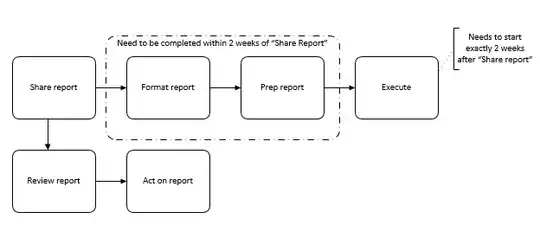I need to model a set of tasks in BPMN v2:
1.0 a report is sent out
following which two paths emanate:
2.0.1report is further formatted, followed by2.0.2additional information is added to the report2.1.1report is reviewed, followed by2.1.2information on the report is acted upon
3.0 further action is taken
I am unable to figure out how to show the following:
(a)
2.0.1,2.0.2and3.0are executed by the same role that executes1.0.(b) from the moment
1.0is completed,2.0.1and2.0.2are to be completed within 2 weeks of that. and then,3.0occurs.(c)
2.1.1and2.1.2are to be (in principle) completed within the same 2-week period, but in case these are not complete,3.0needs to start exactly 2 weeks after1.0.
Can i show the "2-week" stipulation using some combination of event-based gateway, or timer(s) and so on? If so, how?
Here what I have so far:
